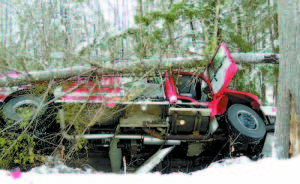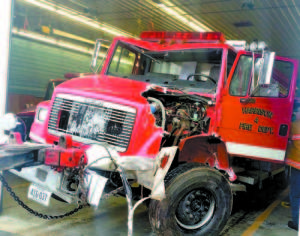Fire response protocols pondered after crash

 AFTER THE ICE SKATE — Engine 4 hit several trees after sliding down Harrison Heights Road Sunday following a fire call.
By Gail Geraghty
Staff Writer
HARRISON — The town of Harrison will review and possibly make changes to its fire response protocols on private roads, said Town Manager George “Bud†Finch, two days after a fire engine slid out of control on the steepest end of Harrison Heights Road and crashed into trees.
“At a minimum I expect a standard for winter plowing and sanding will be required for hills of this magnitude,†said Finch. He also said “the discussion about private roads will be complex, because many of these types of developments have little traffic, and do not have to meet the standards of public roads.â€
Finch’s initial media release on Sunday accident, which destroyed the engine’s chassis but caused only minor injuries to the driver, prematurely stated that is was “possible, maybe probable†that the brakes failed on Engine 4 as it began its descent from the top of Harrison Heights Road down to the Waterford Road. The private development road has a “very, very steep†slope at the Waterford Road entrance, said Finch, and a lesser, but still steep slope at the other end where it loops back to connect with Route 117 in Harrison Village.
Despite his initial assumption, Finch said it now appears unlikely that any mechanical failure was involved in the crash. “That road was just snow and ice. It was covered with very little sand.â€
An accident report is being prepared by Bridgton Police Officer Mac McCormick, who responded to the 11:55 a.m. call when no unit was available from the Cumberland County Sheriffs Department.
Harrison’s Engine 4, a 2000 Freightliner and its first response engine, used the Route 117 entrance to respond to the call, in which a carbon monoxide detector had gone off in a home on the other end of the hill. Finch said “snow and ice conditions made travel difficult†on the trip over, but Engine 4 driver Maurice Kautz, a veteran fire department volunteer, was able to make it to the scene.
Upon arrival, however, it was quickly determined that there was no fire — the CO2 detector had malfunctioned.

EXTENSIVE DAMAGE to the chassis of Harrison’s Engine 4 was clearly evident when it was returned to the fire station.
In preparing to return to the station, Finch said Kautz backed up Engine 4 enough so that another firefighter could remove the wheel chocks. Finch said the sliding began almost immediately once the wheel chocks were removed.
With 1,000 gallons of water on board weighing 8,400 pounds — not to mention the weight of the engine and body alone — it only took a slight forward motion to start a slide. And once the slide started, said Finch, there was just no way for Kautz to stop it.
“He did really good,†all things considered, and is very lucky to have escaped with only minor cuts and bruises that were treated at the scene, said Finch. Unable to stop the forward sliding motion, “(Kautz)
did what he could do to maintain control of the truck†as the fire truck careened down the hill. “The air brake system on a fire truck is designed to lock up,†which causes the tires to generate heat, he said.
Finch said Kautz was able, “for the most part,†to follow his intention to make a right-hand turn onto Route 35 at the bottom of the hill.
“But he was unable to keep the apparatus on the road, as the wheels caught into the shoulder on the far side, causing the engine to roll over sideways into the woods,†Finch said. The front-end chassis was totaled, and it’s still unknown as to how badly the engine itself was damaged. The body, on the other hand, escaped relatively unscathed.
The big fire engine initially impacted at least one tree, shearing it off near the base. After hitting another tree near the driver’s side chassis, the truck finally came to a stop with the felled tree lying parallel on top of it.
“Concern has been raised, fairly in my view, of protocol for responding to private development roads in the wintertime,†Finch said. He said private road residents “rightfully†should expect a response from fire and rescue vehicles, no matter what the physical challenges or distances of their properties. School buses are not required to drive into private road developments, he noted, “and in most cases†don’t go in.
“We will be reviewing, particularly (with) those developments with steep hills, what is the proper protocol for plowing and sanding?†Finch said.

